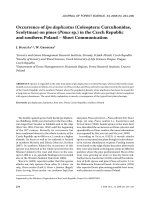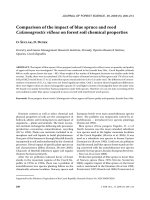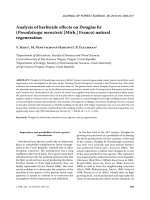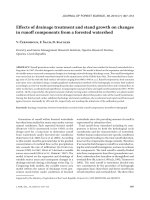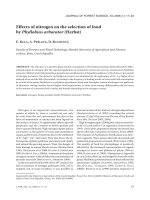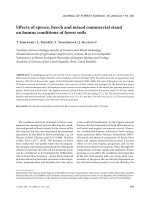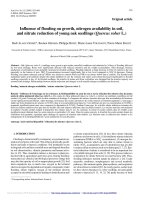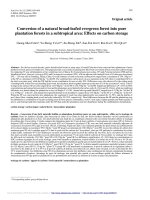Báo cáo lâm nghiệp: "Effects of nitrogen on the selection of food by Phyllobius arborator (Herbst)" pot
Bạn đang xem bản rút gọn của tài liệu. Xem và tải ngay bản đầy đủ của tài liệu tại đây (296.33 KB, 7 trang )
J. FOR. SCI., 54, 2008 (1): 17–23 17
JOURNAL OF FOREST SCIENCE, 54, 2008 (1): 17–23
Nitrogen is an important macroelement, the
uptake of which by trees is carried out not only
by roots from the soil environment but also in the
form of ammonium or nitrate ions from liquids on
the surface of leaves. It significantly affects growth
properties and the creation of below-ground and
above-ground biomass. High nitrogen inputs induce
asymmetry in the growth of roots and assimilatory
organs and the lack of nutrients due to the inhibition
of K
+
, Mg
2+
, Ca
2+
and water. ey also lower the ef-
fectiveness of photosynthesis, increment and vitality
and extend the growing season. us, the danger of
frost damage to annual shoots occurs (M
1995; H et al. 2000; K, F
2002; K, K 2004a). Ammonia in the plants
changes to amino acids and thus the concentration of
proteins increases (S, O 1984).
In the second half of the 90s of the 20
th
century, the
fall of emissions of nitrogen pollutants (NH
3
, NO
x
)
stopped, but at some localities, it was possible to
note an increase of dry and wet nitrogen depositions
(F et al. 2002) exceeding the critical
amount (15 kg N/ha/year) on 4% area of the Krušné
hory Mts. (H 2002, 2004).
High nitrogen inputs (200 kg/ha) reduce insect fau-
na by ⅓ in soil and by ¾ in vegetation (A
1991). As for pine, population density decreased, but
species diversity was preserved (J, P 2006).
e response of Psylloidea to fertilization was, how-
ever, opposite. eir species diversity decreased and
numerical proportion increased (P 1982).
e quality of food for phytophages is positively
affected by the increased concentration of organic
nitrogen in leaves and phloem of plants (W
1984; H et al. 2000). Mining insect Stigmella
sp. and Lithocolletis sp. and imagoes of weevils of the
genus Phyllobius preferred leaves of birch affected by
ammonium sulphate (J, S 1985;
H, V 1993; K, K
2004b). P et al. (1999) mention responses of
Supported by the Ministry of Agriculture of the Czech Republic, Project No. MZe 1G46002, Ministry of Education, Youth and
Sports of the Czech Republic, Project No. MSM 6215648902.
Effects of nitrogen on the selection of food
by Phyllobius arborator (Herbst)
E. K, A. P, D. B
Faculty of Forestry and Wood Technology, Mendel University of Agriculture and Forestry
in Brno, Brno, Czech Republic
ABSTRACT: e selection of a nutritive plant and the consumption of food (Betula pendula Roth) affected by differ-
entiated inputs of nitrogen after the repeated application of ammonium nitrate into soil was monitored at Phyllobius
arborator (Herbst) under field (polythene greenhouse) and laboratory (Climacell) conditions. In birch leaves, the content
of nitrogen increased. e diameter and height increment was stimulated by the application of 0.5–1 g, higher doses
induced stress and the fall of increment. According to the frequency of feeding marks on leaves and food consumption
by weevils of the genus Phyllobius in a polythene greenhouse, birch with the higher content of nitrogen was preferred.
In laboratory rearing, females showed higher food requirements. In short-term rearing, differentiation did not occur
in the amount of consumed food in males and females depending on the nitrogen content.
Keywords: nitrogen; Betula pendula (Roth); Phyllobius arborator (Herbst)
18 J. FOR. SCI., 54, 2008 (1): 17–23
phytophages to air pollution and increased inputs of
nitrogen into plants.
METHODS
The experiment was established in April 2006
by planting one-year birch plants (Betula pendula
Roth) into containers (10-litre volume) with a soil
substrate from the Cambic mineral horizon of forest
soil. Soil properties were modified adding 1 l peat to
a plant. After an interval of three weeks, 128 rooted
birch plants (32 plants in each variant) were placed
into a polythene greenhouse devised to monitor
the ethology of weevils (selection of food). In other
two polythene greenhouses, 480 birch plants were
placed as the source of food for laboratory rearing.
e microclimate of polythene greenhouses in July
at the introduction of weevils of the genus Phyllo-
bius (monitored by a temperature-humidity sensor
AMET) is characterized by mean daily temperatures
18–24°C, daily maximum 21–37°C, daily minimum
11–16°C, daily mean relative air humidity 56–84%,
watering 2–3 times per week, altitude 220 m. Simul-
taneously with a control (T0), changes in the content
of nitrogen were induced in three variants with ap-
plications of 0.5 g (T1), 1 g (T2) and 1.5 g (T3) am-
monium nitrate (NH
4
)NO
3
to a plant into the soil in
four repetitions. e amount of applied ammonium
nitrate was derived from nitrogen depositions in the
Krušné hory Mts. according to data of the Czech
Hydrometeorological Institute in Prague (ČHMÚ).
Growth properties were evaluated according to the
plant height and root collar diameter. e phenology
of leaf fall was quantified on the level of a plant in
categories 0.1–5, 6–25, 26–50, 51–75, 76–100% at
the simultaneous registration of colour changes.
Imagoes of the genus Phyllobius were released into
the area of the polythene greenhouse (2. 7. 2006).
After 14 days, leaves damaged by feeding were reg-
istered in all plants of the experiment (128). Under
laboratory conditions, individual rearings of Phyllo-
bius arborator (Herbst) (34 ♂♂, 46 ♀♀) were estab-
lished in Petri dishes of a diameter of 13.5 cm. At an
interval of 48 hours, branches with birch leaves were
offered to the weevil in variants T0–T3 (24 repe-
titions). e rearings were placed into a Climacell
707 with a set up 10-hour day-time (temperature
24°C, relative air humidity 40%, insolation 100%) and
6-hour night-time regime (temperature 14.4°C, rela-
tive air humidity 60%, insolation 0%) (with a 4-hour
gradual transition between them) for the period of
monitoring (6 days).
Using a Leave Area Meter (AM 300), the area of
leaves with feeding marks was scanned right on the
Table 1. Characteristics of a soil substrate for growing nutritive plants
pH
KCl
pH
H
2
O
Nkjehl C
ox
C:N
N-NH
4
+
N-NO
3
–
Σ N-min
(%) (mg/kg)
Starting position Ø 3.47 ± 0.01 4.43 ± 0.03 0.08 ± 0.00 2.08 ± 0.22 25.4 ± 2.95 2.81 ± 1.47 8.23 ± 1.2 11.03 ± 2.28
Variant
T0 3.48 4.16 0.10 1.89 18.9 6.12 5.68 11.80
T1 3.38 3.99 0.08 1.64 20.5 31.20 28.30 59.50
T2 3.40 3.93 0.09 2.12 23.6 67.10 44.10 111.20
T3 3.37 3.91 0.10 1.48 14.8 75.70 59.60 135.30
J. FOR. SCI., 54, 2008 (1): 17–23 19
plant. e extent of damage was calculated using
the Photoshop program with the resolution of 64 ×
240 pixels.
e chemistry of a mixed soil sample was analyzed
before the experiment establishment and then at the
end of the growing season from variants T0-T3 by
an accredited laboratory Ekola Ltd. Bruzovice. Fol-
lowing analyses were carried out: oxidizable carbon
(C
ox
), C:N (C
ox
/Nkjehl) ratio, the content of available
nutrients N-NO
3
–
, N-NH
4
+
(determined in the leach
in 1% potassium sulphate solution), pH value (H
2
O,
KCl) (Table 1). e C:N fluctuation could be caused
by the uneven proportion of the originally applied
peat substrate in the mixed soil sample.
After the completion of weevil feeding, leaves were
sampled from branches in the tree profile (except
four terminal). e leaves were then analyzed after
drying at 70°C. Nitrogen was determined according
to Kjeldahl using a tecator Kjeltec analyzer UNIT
2300 device. ANOVA LSD test (Statistica Cz) was
used for statistical evaluation.
RESULTS
Effects on a nutritive plant
A basic condition of the rapid increase in the nitro-
gen content in birch leaves was demonstrated by the
analysis of its level in the dry matter of leaves during
the spring season. e amount of nitrogen increased
nonlinearly with the increasing rate of ammonium
nitrate into the substrate, differences being statisti-
cally significant (P < 0.001 at the significance level
α = 0.05); only between variants T2 and T3, statisti
-
cally significant differences were not found (T0 24.8;
T1 29.8; T2 32.0; T3 32.9 mg/g) (Fig. 1).
Differentiated inputs of nitrogen caused different
non-linear diameter and height increments in birch
plants. Differences in the height increment were
statistically significant (P < 0.001 at the significance
level α = 0.05) only between the control (40.5 cm)
and variants with nitrogen applications (49.5 to
53.9 cm), however, not between particular doses of
34
32
30
28
26
24
T0 T1 T2 T3
Variant
N (mg/g)
T0 T1 T2 T3
Variant
60
56
52
48
44
40
36
(cm)
Fig. 2. Mean height increment of birch (0.95 reli-
ability intervals)
Fig. 1. Mean content of nitrogen in the dry matter
of birch leaves depending on the application of
ammonium nitrate (0.95 reliability intervals)
20 J. FOR. SCI., 54, 2008 (1): 17–23
nitrogen (Fig. 2). Changes in the diameter of a root
collar correspond to findings mentioned above be-
cause statistical differences occurred only between
the control (2.7 mm) and variants with nitrogen
(3.5–3.7 mm) (Fig. 3). With an increased rate of
nitrogen (1.5 g), statistically insignificant decrease
occurred in the height and diameter increment.
As for the fall of leaves at the end of the growing
season, no differences were noted between particular
variants. On the basis of the evaluation of colour
changes at the end of the growing season using non-
parametric statistics (Kruskal-Wallis test) a statisti-
cally significant difference occurred (P < 0.001 at the
significance level α = 0.05) between the control (T0)
when leaves of plants got yellow more intensively and
variants affected by nitrogen.
Selection and consumption of food
In a polythene greenhouse, P. arborator damaged
birch leaves in all variants in a differentiated range
from 336 (T0) to 430 leaves (T2) (Fig. 4). Differences
in the frequency of the feeding mark occurrence were
not accidental (χ
2
= 12.67, df = 3, P = 0.005). Insect
attack increased with the increasing mean content of
nitrogen in the dry matter of leaves from variant T0
(24.8 mg/g) to variant T2 (32 mg/g)
(Fig. 5) while at
the nitrogen level of 32.9 mg/g (T3) the attack mod-
erately decreased. is conclusion also corresponds
to the amount of food in the control (T0 – 51 cm
2
)
and in variant T2 (69 cm
2
) (Fig. 6) and converted dry
matter (194–263 mg) (Fig. 7).
In the laboratory rearing of P. arborator imagoes,
statistically significant differences were found in the
consumption of leaf biomass by males and females
not distinguishing variants (P < 0.001, Fig. 8). Females
consumed on average 60.6 ± 15.4 mm
2
per day leaf area
(2.3 mg dry matter per day) while males consumed
on average 45.7 ± 10.5 mm
2
/day
(1.7 mg dry matter
per day). Differences between particular variants in
4.0
3.6
3.2
2.8
2.4
(mm)
T0 T1 T2 T3
Variant
Fig. 3. Mean diameter increment of birch in a
root collar depending on the application of am-
monium nitrate (0.95 reliability intervals)
T3
T2
T1
T0
300
340
380
420
460
24 26 28 30 32 34
Nitrogen (mg/g)
Feeding marks (pcs)
336
394
430
412
0
100
200
300
400
500
T0 T1 T2 T3
Variant
Feeding marks (pcs)
Variant
Fig. 4. e number of feeding marks created by weevils of the
genus Phyllobius on birch leaves affected by differentiated
inputs of nitrogen
Fig. 5. Relationship between the occurrence of feeding marks
of weevils of the genus Phyllobius and the content of nitrogen
in birch leaves
J. FOR. SCI., 54, 2008 (1): 17–23 21
the consumption of food by males and females were
not statistically significant (Figs. 9 and 10).
DISCUSSION
Data given by M (1995) showing that
nitrate ions or ammonium cations, which were
added in the form of ammonium nitrate to the soil
substrate, were taken by a plant very well were dem-
onstrated in an experiment with B. pendula. eir
uptake began to be limited only after the nitrogen
content in leaves exceeding a value of 32 mg/g
dry
matter. Higher levels can be connected with a nega-
tive response induced by the nitrogen surplus when
the content of nitrogen ions in the substrate probably
acted as a stress factor causing the disturbance of the
uptake of other nutrients (K, F
2002).
P. arborator attacked more frequently plants
with the increased nutrition of nitrogen according
to conclusions on stress impacts (K, K
2004b, 2005). Changed nutrition or stress could af-
fect the quality aspects of food, e.g. the production
of secondary metabolites and thus, the acceptability
of plant biomass for phytophages (M 1980;
W 1984; B et al. 1993). However, it is
necessary to take into account the different response
of particular plant species to stress and subsequently
the differentiated response of insect induced by
changes in the quality of food (L 1989).
erefore, the response of P. arborator cannot be
generalized. Other species or the same insect spe-
cies on another plant species can behave differently
(H, V 1993).
The amount of biomass consumed by weevils
depending on a variant did not differ. Significant
differences between males and females are not sur-
prising because, in general, females show higher
food requirements for the creation of a fat body and
eggs. K (1988) mentions similar results in the
increased consumption of food in the creation of a fat
body in females of Lochmaea caprae (L.) Differences
of imagoes in the consumption of food in particular
variants cannot be confronted with findings obtained
under conditions of the polythene greenhouse where
5,105
5,553
6,914
6,628
0
1,500
3,000
4,500
6,000
7,500
T0 T1 T2 T3
Variant
(mm
2
)
194
211
263
252
0
50
100
150
200
250
300
350
T0 T1 T2 T3
Variant
mg
Fig. 6. Weevils of the genus Phyllobius – consumption of food
on birch affected by differentiated inputs of nitrogen
Fig. 7. e weight of the dry matter of birch leaves affected by
the application of ammonium nitrate consumed by weevils of
the genus Phyllobius
Fig. 8. Differences in the consumption of food by
Phyllobius arborator according to sex (laboratory
rearing)
(mg)
400
360
320
280
240
f m
Sex
(mm
2
)
22 J. FOR. SCI., 54, 2008 (1): 17–23
the proportion in feeding according to sex could not
be evaluated.
CONCLUSION
e input of nitrogen into a plant through soil
became evident by the increased content of nitrogen
in birch leaves and changes in height and diameter
increment. Applications of ammonium nitrate up to
1 g to a plant (32 mg/g) showed stimulation effects,
higher rates induced stress and fall in increment.
The frequency of feeding marks and the con-
sumption of food by weevils of the genus Phyllo-
bius proved their preference to plants affected by
nitrogen.
In general in laboratory rearings (Climacell), in-
creased uptake of food occurred in females. Effects
of the various level of nitrogen in food did not dif-
ferentiate the height of uptake within a sex.
R e f e r e n c e s
ANONYMOUS, 1991. IUCN East European Programme,
the lowland grasslands of Central and Eastern Europe.
Environmental Research Ser., 4: 1.
BRYANT J.P., REICHARDT P.B., CLAUSEN T.P., WERNER
R.A., 1993. Effect of mineral nutrition on delayed inducible
resistance in Alaska paper birch. Ecology, 74: 2072–2084.
FADRHONSOVÁ V., ŠRÁMEK V., KROUPOVÁ M., 2002
.
Vývoj depozic v oblasti Krušných hor. In: Sborník referátů
Výsledky lesnického výzkumu v Krušných horách v roce 2001,
Teplice 14. 3. 2002. Jíloviště-Strnady, VÚLHM: 49–54.
HADAŠ P., 2002
. Celková potenciální depozice síry, dusíku
a vodíkových iontů na území PLO Krušné hory v roce
1999. In: Sborník referátů Výsledky lesnického výzkumu
v Krušných horách v roce 2001, Teplice 14. 3. 2002. Jíloviště-
Strnady, VÚLHM: 55–66.
HADAŠ P.,
2004. Potenciální podkorunové depozice síry,
dusíku a iontů vodíku na území PLO Krušné hory v roce
500
450
400
350
300
250
200
T0 T1 T2 T3
Variant
(mm
2
)
500
450
400
350
300
250
200
T0 T1 T2 T3
Variant
(mm
2
)
Fig. 9. Mean consumption of food by females of
Phyllobius arborator after 6 days of feeding in a
laboratory rearing (0.95 reliability intervals)
Fig. 10. Mean consumption of food by males of
Phyllobius arborator after 6 days of feeding in a
laboratory rearing (0.95 reliability intervals)
J. FOR. SCI., 54, 2008 (1): 17–23 23
2001. In: Sborník referátů Výsledky lesnického výzkumu
v Krušných horách v roce 2003, Teplice 22. 4. 2004. Jíloviště-
Strnady, VÚLHM: 13–28.
HADDAD N.M., HAARSTAD J., TILMAN D., 2000
. e
effects of long-term nitrogen loading on grassland insect
communities. Oecologia, 124: 73–84.
HEILMEIER H., BARONIUS K., KUHN A.J., NEBE W., 2000
.
Biomass and nutrient relationships of Betula pendula, Fagus
sylvatica, Picea abies and Abies alba with varying nitrogen
and sulphur additions in a pot experiment. Forstwissen-
schaftliches Centralblatt, 119: 161–176.
HELIÖVAARA K., VÄISÄNEN R., 1993
. Insects and Pollu-
tion. Boca Raton, CRC Press Inc.: 393.
INGESTAD T
., 1990. Nitrogen and plant grow; maximum
efficiency of nitrogen fertilizers. In: PERALA D.A., ALM
A.A., Reproductive ecology of birch: A Review. Forest Ecol-
ogy and Management, 32: 1–38.
JANSSON R.K., SMILOWITZ Z.,
1985. Influence of nitrogen
on population parameters of potato insects: abundance,
population growth and within-plant distribution of the
green peach aphid, Myzus persicae (Homoptera: Aphididae).
Environmental Entomology, 15: 49–55.
JONES M.E., PAINE T.
D., 2006. Detecting changes in insect
herbivore communities along a pollution gradient. Envi-
ronmental Pollution, 143: 377–387.
KAŇOVÁ D., KULA E.,
2004a. e effect of stress factors
on birch Betula pendula Roth. Journal of Forest Science,
50: 399–404.
KAŇOVÁ D., KULA E.,
2004b. Vliv stresu na břízu Betula
pendula Roth a její atraktivitu pro fytofágy. [Projekt NAZV
QC 1144/2001.] Brno, MZLU: 82.
KAŇOVÁ D., KULA E.,
2005. Effect of experimental acidifi-
cation on birch Betula pendula Roth and several feed-linked
insects. In: International Conference Acid Rain 2005, June
12–17 2005. Prague, Czech Hydrometeorological Institute:
626.
KULA E., 1988.
e willow leaf beetle (Lochmaea capreae L.) in
birch stands. Acta Universitatis Agriculturae, 57: 261–307.
KULHAVÝ J., FORMÁNEK P., 2002. Dusík v lesních eko
-
systémech Krušných hor. In: Sborník referátů Výsledky
lesnického výzkumu v Krušných horách v roce 2001, Teplice
14. 3. 2002. Jíloviště-Strnady, VÚLHM: 37–46.
LARSSON S., 1989.
Stressful times for the plant stress – insect
performance hypothesis. Oikos, 56: 277.
MARSCHNER H.,
1995. Mineral Nutrition of Higher Plants.
2
nd
Ed. London, Academic Press: 889.
MATTSON W.J.,
1980. Herbivory in relation to plant nitro-
gen content. Annual Review of Ecology and Systematics,
11: 119.
PRESTIDGE R.
A., 1982. e influence of nitrogenous fer-
tilizer on the grassland Auchenorrhyncha (Homoptera).
Journal of Applied Ecology, 19: 735–749.
PRONOS J., MERRILL L., DAHLSTEN D.,
1999. Insects and
pathogens in a pollution-stressed forest. Oxidant air pollu-
tion impacts in the montane forests of Southern California:
A case study of the San Bernardino Mountains. Ecological
Studies, 134: 317–337.
SRIVASTAVA H.S., ORMROD D.P., 1984. Effects of nitrogen
dioxide and nitrate on growth and nitrate assimilation in
bean leaves. Plant Physiology, 76: 418.
WHITE T.C.R.,
1984. e abundace of invertebrate herbivores
in relation to the availability of nitrogen in stressed food
plants. Oecologia (Berlin), 6: 90–105.
Received for publication June 23, 2007
Accepted after corrections October 16, 2007
Vliv dusíku na výběr potravy listohlodem stromovým (Phyllobius arborator
Herbst)
ABSTRAKT: Výběr živné rostliny a spotřeba potravy (Betula pendula Roth) ovlivněné diferencovanými vstupy dusíku
po opakované aplikaci dusičnanu amonného do půdy byl sledován u Phyllobius arborator (Herbst) v podmínkách
terénních (fóliovník) a laboratorních (Climacell). V listech břízy se zvýšil obsah dusíku. Tloušťkový a výškový přírůst
byl stimulován aplikací 0,5–1 g (NH
4
)NO
3
, vyšší dávky vyvolaly stres a pokles přírůstu. Podle frekvence požerků na
listech a spotřeby potravy nosatci rodu Phyllobius ve fóliovníku byla preferována bříza s vyšším obsahem dusíku.
V laboratorním chovu měly vyšší potravní nároky samice, přičemž se v krátkodobém chovu neprojevila diference
u samců a samic v množství přijaté potravy v závislosti na obsahu dusíku.
Klíčová slova: dusík; Betula pendula (Roth); Phyllobius arborator (Herbst)
Corresponding author:
Prof. Ing. E K, CSc., Mendelova zemědělská a lesnická univerzita v Brně, Lesnická a dřevařská fakulta,
Lesnická 37, 613 00 Brno, Česká republika
tel.: + 420 545 134 127, fax: + 420 545 211 422, e-mail:
